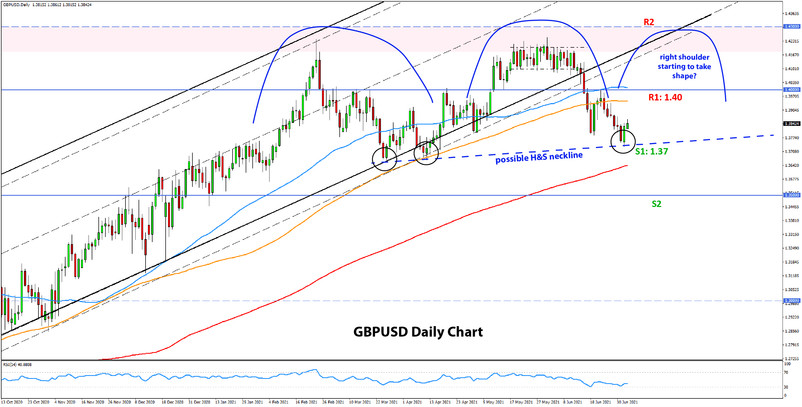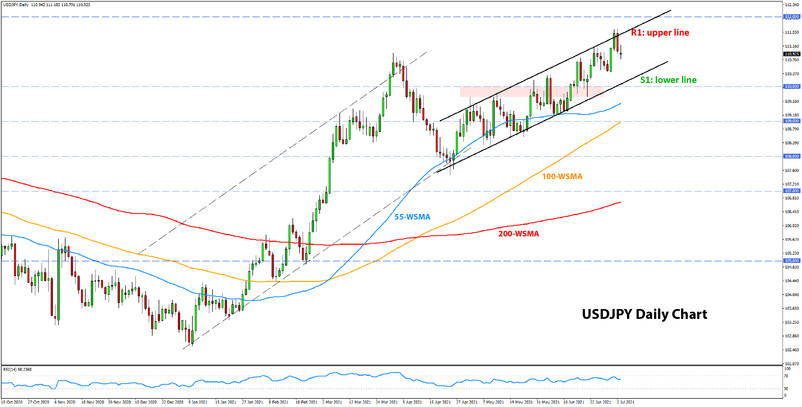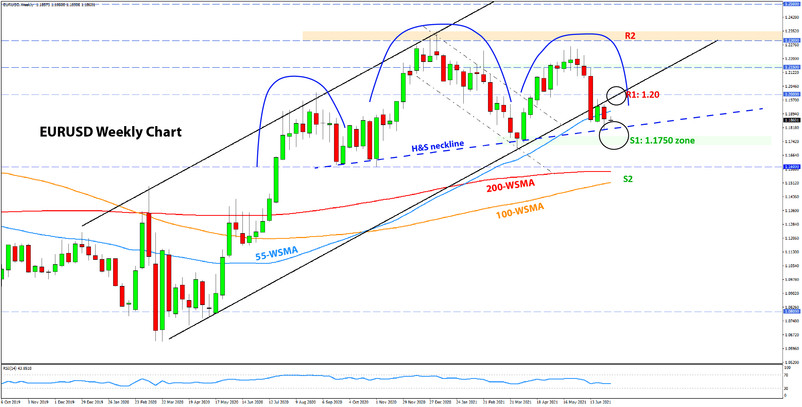US Dollar Fundamental Outlook: USD Sold as NFP “Not Good Enough” for Bulls
The solid 850K Nonfarm payrolls print last Friday beat the consensus forecasts of 720K, yet the dollar was sold on the day. The reaction likely reflects short-term overbought USD positioning and a disappointment of bulls who hoped for an even stronger NFP report in the likes of 1M+ jobs. Furthermore, there was a slight disappointment in the other components of the jobs data, namely average hourly earnings (wage growth) were weaker than expected, and the unemployment rate rose to 5.9% instead of falling to 5.7%.
Overall, there was nothing in Friday’s NFP and other jobs reports that will make the Fed more hawkish. Rather, the overall takeaway is that the Fed will remain comfortable with its current stance of “inflation is transitory and we need further progress in the labor market”, which means they are in no rush to tighten policy. Hence, the disappointment of dollar bulls.
The light USD calendar starts with the July 4th US Independence Day holiday, which usually means we get very low trading volumes in the Fx market. Then tomorrow (Tuesday), the Institute for Supply Management (ISM) publishes the closely watched service PMI report, while on Wednesday, the Fed will publish the meeting minutes from their (market-moving) June 16 meeting. Some further hawkish surprises in the Fed minutes report perhaps could move the market again, though that is unlikely as Fed Chair Powell and other Fed Presidents spoke extensively since the June 16 meeting and played down the prospects for tightening.
Euro Fundamental Outlook: Slower Growth and Inflation in Eurozone Likely to Limit EUR’s Potential
The euro ended the past week lower, though the trend remains generally neutral, with the losses being modest in most EUR pairs. At present, there is little to suggest that the ongoing dynamics of a broadly neutral (range-bound) euro will change.
On a comparative basis, the outlook for both inflation and GDP in the Eurozone is lower than in the United States and some other developed nations, and is likely to remain so over the coming months. As last week’s Eurozone inflation data showed, y/y prices increased only 1.9%, while inflation is already at 5.0% in the US. This divergence will likely keep the EURUSD pair pressured over the summer as it will translate into a central bank divergence between the ECB and the Fed. Namely, the ECB is currently in no rush to think about tightening policy with inflation rates still below 2%, but that is not the case with the Fed.
The EUR economic calendar features no market-moving events this week, but the ZEW economic sentiment index and EU commission forecasts will be watched. The euro will likely be influenced more by global factors and developments with other currencies this week than domestic factors.
EURUSD Technical Analysis:
The bears managed to take EURUSD to a new lower low last week, but were not able to hold it, and the pair is now back where it was two weeks ago, near 1.1850. Overall, not much has changed on the larger EURUSD picture, as shown on the weekly chart below.
The trend dynamics remain bearish, but support is not far either, initially found at 1.18 and the more important one at 1.1750. This, combined with Friday’s bounce, argues for a near-term correction higher that could take EURUSD toward the 1.20 key resistance zone.
A potential head and shoulders pattern is also emerging into focus on this chart. The neckline can be drawn by connecting the October and March lows, which projects the line’s current location toward the same 1.1750 support area noted above.
British Pound Fundamental Outlook: Not Budging Much About Surging Infections with Delta Variant
The skyrocketing number of new infections with the more contagious delta variant is not followed by a rise in Covid related deaths. That is the good news from the UK so far. Still, markets can’t remain completely complacent and this is having traders on edge. Although the UK government has announced that the plan for reopening on July 19 will go through, the risks of a rise in serious and death cases are not to be neglected.
Other than developments with Covid, the UK goes from a light calendar last week into another light schedule this week. Namely, the m/m GDP report and a speech from BOE Governor Bailey on Friday will be the highlights of the week. Among other events, the UK will report services and construction PMIs, and industrial and manufacturing production.
The rapid developments with the outbreak of the delta variant will continue to dominate GBP trading this week. The risks of a rise in the death rate should keep the pound away from strengthening, but the good news that the vaccines still protect against the delta variant should also keep GBP losses limited. Overall, a continuation of a range-bound GBP looks like the most probable scenario, with that being most evident on pairs such as GBPUSD and EURGBP.
GBPUSD Technical Analysis:
GBPUSD bounced off the 1.37 support zone last week as a rejection of downside continuation of the post-Fed sell-off. An interesting question now is, if this bounce marks the start of the right shoulder of the potential head and shoulders pattern (see chart). If so, it’s going to take a few more weeks, at least for the shoulder to take shape.
The overall picture is more balanced now after last week’s bounce at the 1.37 support. The more significant support remains at the 1.35 area, but it’s not in immediate focus now. To the upside, the first key weekly resistance is at 1.40, while the next one higher is at the 1.43 zone.
The support at 1.37 and the resistance at 1.40 appear quite solid, which argues that GBPUSD may now enter a new trading range, which would be defined between those two zones.

Japanese Yen Fundamental Outlook: JPY Doing What It Usually Does
USDJPY remains as stuck as ever and seemingly continues to be driven more by technicals rather than fundamentals (see next section). US Treasury yields, the usual factor that influences the USDJPY pair, are capped in ranges also.
In the meantime, risk appetite has returned over the past couple of weeks, with the S&P 500 and other stock indices at new all-time highs. As long as this dynamic remains in full effect, JPY volatility is only likely to remain subdued. That often means that the path of least resistance for the yen remains lower (JPY pairs higher), with USDJPY remaining a primary proxy for gauging general JPY trends.
USDJPY Technical Analysis:
USDJPY managed to extend to the upside above 111.00 last week as part of its ascending channel formation, but the move was only modest and is already being retraced. USDJPY is now back below 111.00 and remains firmly between the two lines of the channel.
111.00 could still hold as a weekly resistance zone (the weekly candle closed below 111.00), and a double top could still be formed here. But last week’s price action suggests that the ascending channel is more important in the current context than any horizontal support or resistance zones. Thus, its eventual breakout could bring about some attractive trading opportunities, particularly from the short side.
As defined by the channel lines, the key support and resistance zones currently come in around 110.15 and 111.50, respectively. Remember, since the lines are ascending, the S/R levels are dynamic and are moving higher accordingly.






